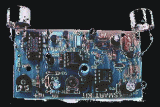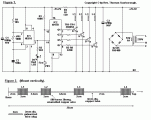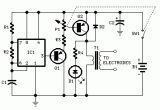Beeps when hears your whistle
A gadget suitable for key-holders, games etc.
Parts:
R1 22K 1/4W Resistor
R2 10K 1/4W Resistor
R3 4M7 1/4W Resistor
R4,R8 100K 1/4W Resistors
R5 220R 1/4W Resistor
R6 330K 1/4W Resistor
R7 47K 1/4W Resistor
R9 2M2 1/4W Resistor
R10 1M5 1/4W Resistor
C1,C5 47nF 63V Polyester or Ceramic Capacitors
C2,C3 10nF 63V Polyester Capacitors
C4,C6 1µF 63V Electrolytic Capacitors
D1,D2 1N4148 75V 150mA Diodes
IC1 4049 Hex Inverter IC
Q1 BC337 45V 800mA NPN Transistor
MIC1 Miniature electret microphone
BZ1 Piezo sounder (incorporating 3KHz oscillator)
B1 2.8 or 3V Battery (see notes)
Device purpose:
Some 15 years ago it was common to see small key-holders emitting an intermittent beep for a couple of seconds after its owner whistled. These devices contained a special purpose IC and therefore were not suited to home construction. The present circuit is designed around a general purpose hex-inverter CMos IC and, using miniature components and button clock-type batteries can be enclosed in a matchbox. It is primarily a gadget, but everyone will be able to find suitable applications.
Circuit operation:
This device beeps intermittently for approx. two seconds when a person in a range of about 10 meters emits a whistle.
The first two inverters contained in IC1 are used as audio amplifiers. IC1A amplifies consistently the signal picked-up by the small electret-microphone and IC1B acts as a band-pass filter, its frequency being centered at about 1.8KHz. The filter is required in order to select a specific frequency, the whistle's one, stopping other frequencies that would cause undesired beeper's operation. IC1C is wired as a Schmitt trigger, squaring the incoming audio signal. IC1D is a 2 second (approx.) monostable driving the astable formed by IC1E & IC1F. This oscillator generates a 3 to 5Hz square wave feeding Q1 and BZ1, thus providing intermittent beeper's operation.
Notes:
Power supply range: 2.6 to 3.6 Volts.
Standing current: 150µA.
Depending on dimensions of your box, you can choose from a wide variety of battery types:
2 x 1.5 V batteries type: AA, AAA, AAAA, button clock-type, photo-camera type & others.
2 x 1.4 V mercury batteries, button clock-type.
1 x 3 V or 1 x 3.6 V Lithium cells.
Author: RED Free Circuit Designs
Email:
Website: http://www.redcircuits.com/

 Audio
Audio







